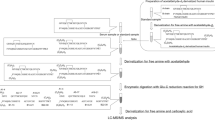Summary
One classical method for quantitation of amino acids in proteins is hydrolysis of the proteins and determination of the free amino acids. Although the drastic experimental conditions necessary for complete hydrolysis always cause degradation of some of the amino acids, if mild hydrolysis conditions are used, a mixture of amino acids and oligopeptides is obtained. If these conditions are adequately tuned, the oligopeptides are almost exclusively dipeptides. For this reason we have initiated a study to find a derivatizing agent suitable for the analysis of amino acids and dipeptides by an absolute method of quantitation already tested for amino acids. FMOC-Cl was found to be a suitable derivatizing agent for this purpose.
Similar content being viewed by others
References
D. Roach, C. W. Gehrke, J. Chromatogr.52, 393 (1970).
G. J. Schmidt, D. C. Olson, W. Slavin, J. Liq. Chromatogr.2, 1031 (1979).
B. N. Jones, P. Paabo, S. Stein, J. Liq. Chromatogr.4, 565 (1981).
S. Einarsson, B. Josefsson, S. Lagerkvist, J. Chromatogr.282, 609 (1983).
U. Bütikofer, D. Fuchs, J. O. Bosset, W. Gmür, Chromatographia31, 441 (1991).
J. R. E. Lewis, J. S. Morley, R. F. Venn, J. Chromatogr.615, 37 (1993).
A. G. Schepky, K. W. Bensch, P. Schulz-Knappe, W.-G. Forssmann, Biomed. Chromatogr.8, 90 (1994).
J. Kirschbaum, B. Luckas, W. D. Beinert, Int. Lab. July/August, 27 (1994).
J. M. Roturier, D. Le Bars, J. C. Gripon, J. Chromatogr. A696, 209 (1995).
J. K. Lim, C. H. Wang, Clin. Chem.26, 579 (1980).
R. L. Heinrikson, S. C. Meredith, Anal. Biochem.136, 65 (1984).
G. Torsi, G. Chiavari, C. Laghi, A. M. Asmundottir, F. Fagioli, R. Vecchietti, J. Chromatogr.482, 207 (1989).
G. Torsi, G. Chiavari, C. Laghi, A. M. Asmundottir, J. Chromatogr.518, 135 (1990).
G. Torsi, G. Chiavari, M. T. Lippolis, LC-GC Int.1(5), 37 (1991).
G. Torsi, A. M. Gioacchini, N. Gandini, Annali di Chimica83, 345 (1993).
B. Gustavsson, I. Betner, J. Chromatogr.507, 67 (1990).
Author information
Authors and Affiliations
Rights and permissions
About this article
Cite this article
Melucci, D., Xie, M., Reschiglian, P. et al. FMOC-Cl as derivatizing agent for the analysis of amino acids and dipeptides by the absolute analysis method. Chromatographia 49, 317–320 (1999). https://doi.org/10.1007/BF02467563
Received:
Revised:
Accepted:
Issue Date:
DOI: https://doi.org/10.1007/BF02467563




